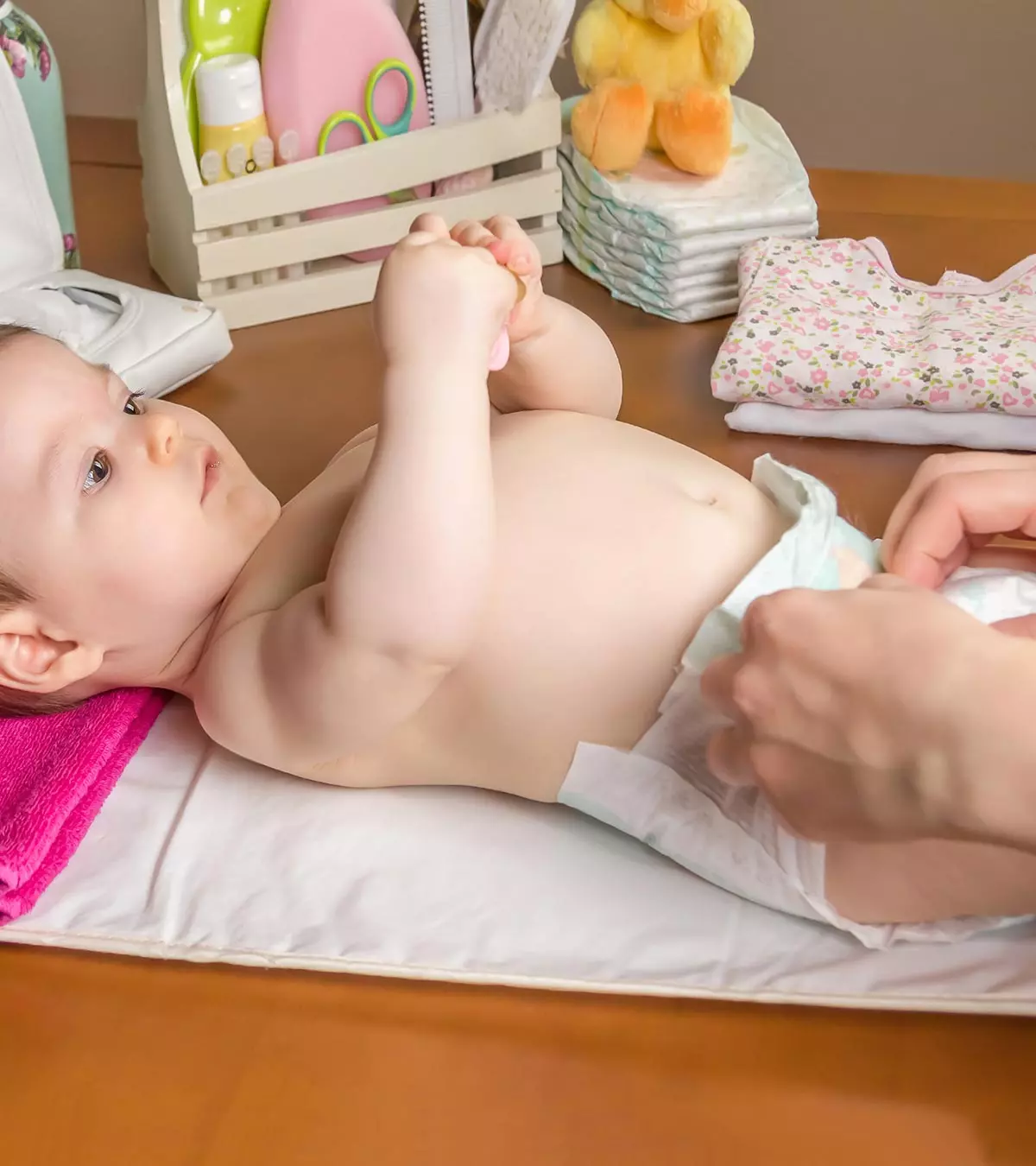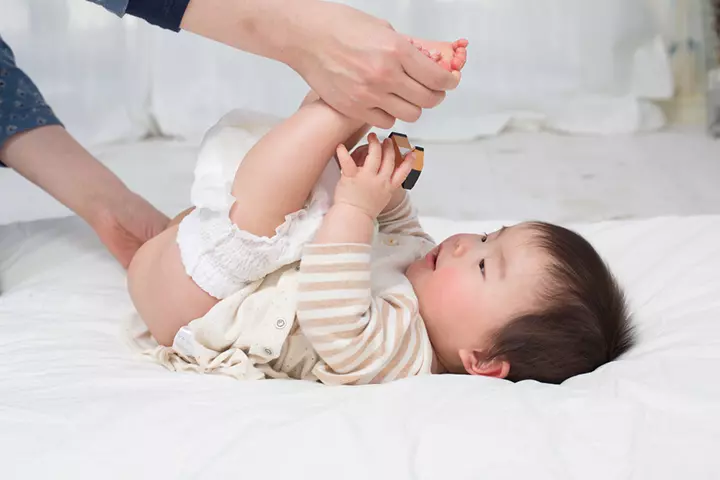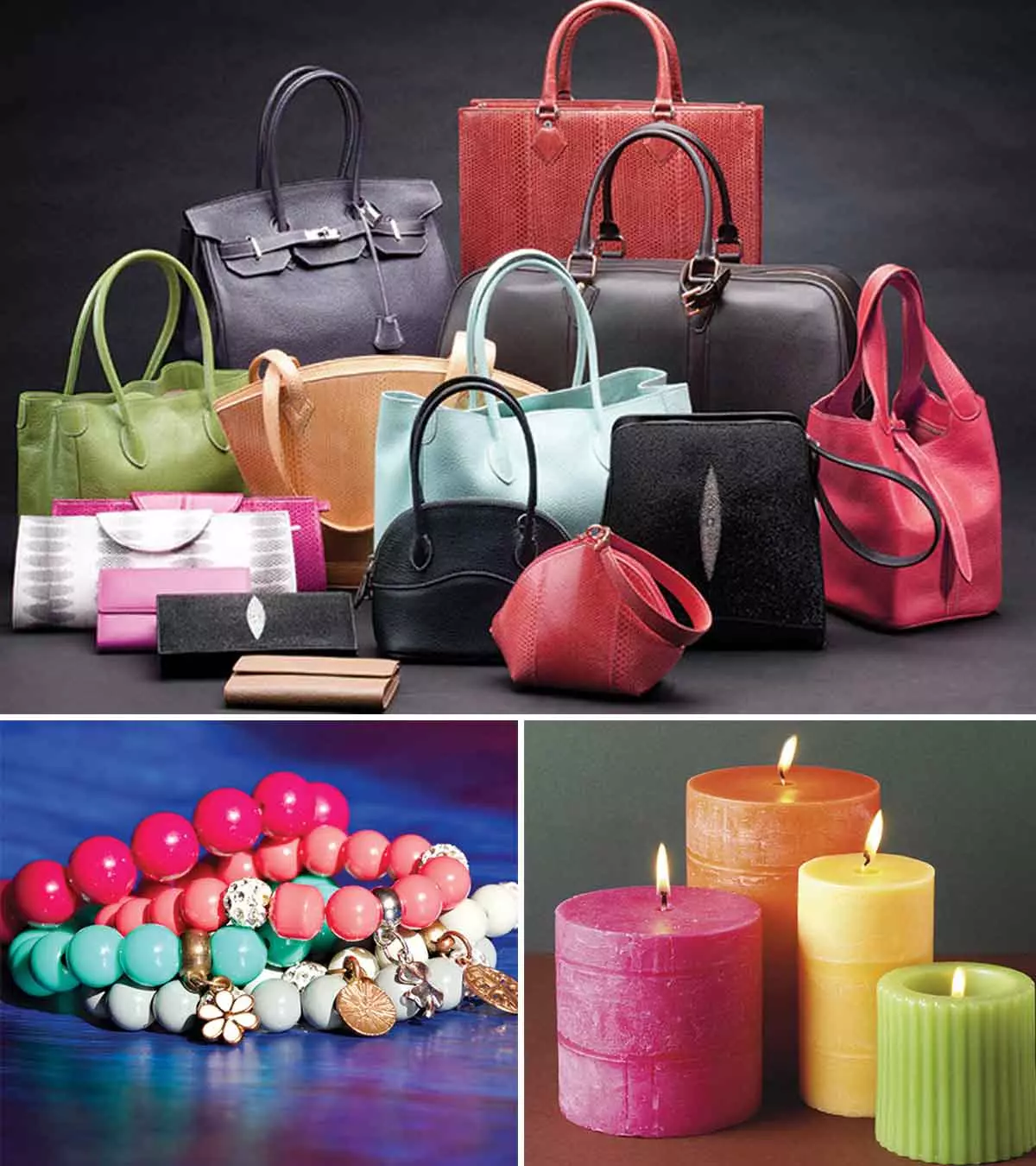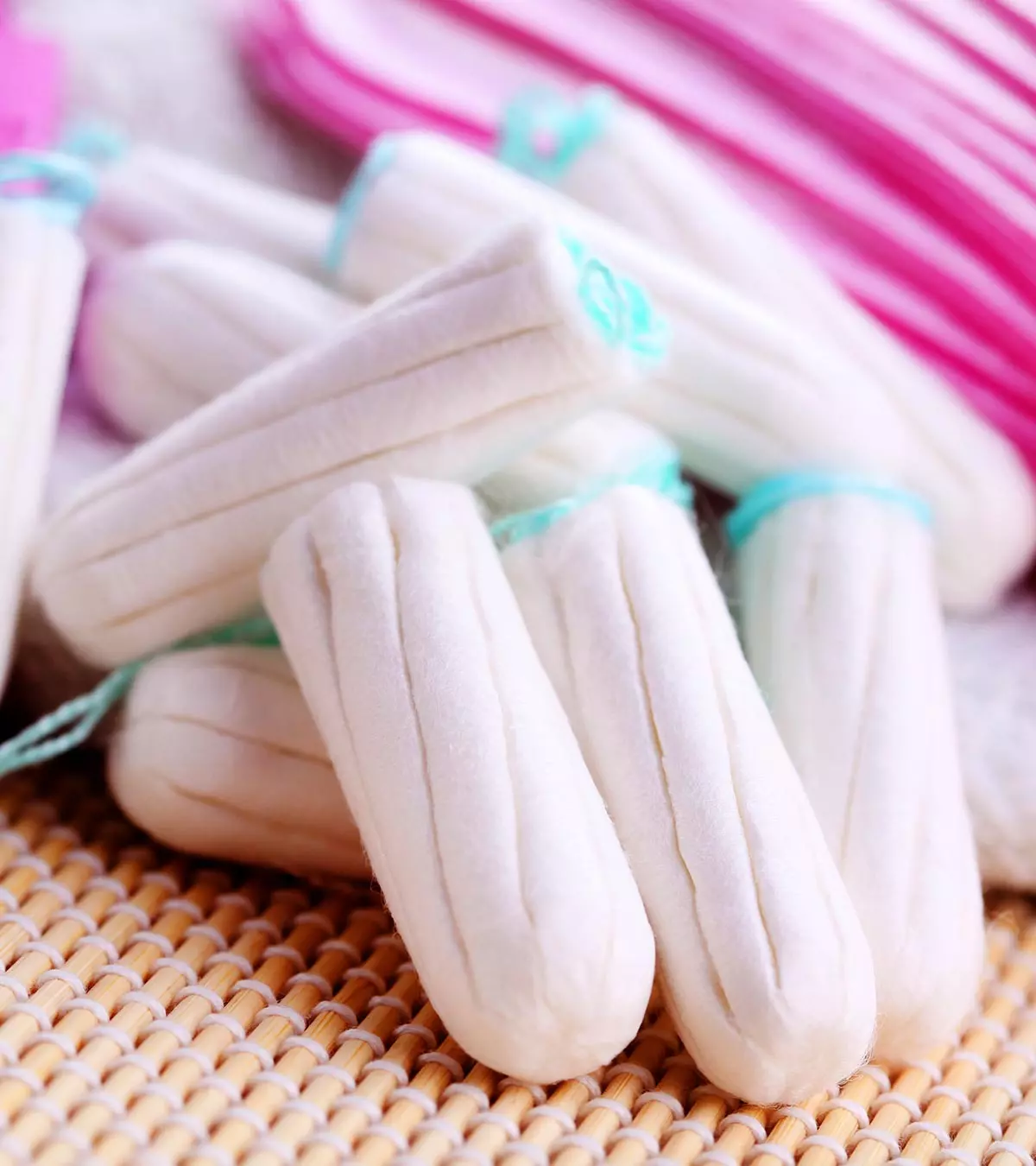
Image: Shutterstock
During the first several months, your newborn’s activities will be limited, with passing stool and urine being at the top of the list. They will regularly wet their bed, and so, you must make the necessary preparations to ensure that your baby remains comfortable and dry. Disposable and biodegradable diapers for babies are one alternative that many mothers choose these days. However, you might wonder, “Is it safe to use diapers on a newborn baby?” “How do I use diapers correctly?” “Can newborns wear diapers all day?” and so on. This post covers all of these questions about diapers, as well as measures to take and their comparisons with cloth nappies.
Key Pointers
- Disposable diapers use dyes, sodium polyacrylate, and bleached wood pulp, and need frequent changing to prevent infections.
- Cloth diapers are a more economical, easy-to-handle, and chemical-free option.
- Limiting diaper usage to nighttime and changing them when wet or dirty can help prevent leakage and rashes.
- Disposable diapers may contain or release harmful toxins such as dioxins, toluene, and xylene, making careful selection important to avoid skin irritation.
Is Diaper Safe For Baby And When To Use Diapers?
Are diapers safe for babies? This is one question that every mother would want to know. Well, diapers are said to be safe for babies who are barely even a day old. In fact, some diapers are specially made for newborn babies. But you must take some precautions (1):

Image: Shutterstock
- Watch your baby’s skin when changing diapers to check whether there are rashes or not. Some little ones have more sensitive skin than others. A cross-sectional study conducted by multiple institutions found that the prevalence of diaper dermatitis in the US was 8.7%.
- Disposable diapers, which soak more liquid, should preferably be used at night, when it is inconvenient to change them frequently. During the day, you can stick with other options.
- It is important to change diapers every two to three hours. Keeping the baby longer than this period with a used diaper can cause infections or rashes.
- When the baby passes stool, then it is a must to change the diaper immediately to maintain hygiene.
- Keeping diapers handy for journeys or outings will make life easier for you.
 Did you know?
Did you know?Diaper vs. Cloth Nappy

Image: Shutterstock
There are many people who would prefer a cloth nappy over a disposable diaper. There are many reasons for this (2):
- Cloth has been used by mothers for centuries, whereas diapers are a rather recent innovation.
- There are many cloth diapers available in the market now which are easy to handle.
- Cloth nappies or diapers can be washed and are reusable. Hence, they are much more economical than disposable ones.
- Some parents are doubtful about the chemicals that are used to make diapers and are afraid that they might cause problems.
- Cloth nappies have to be changed frequently. This ensures that the baby is not lying in its excreta.
- Many people are also of the view that diapers play a role in delaying potty training since kids are so habituated to wearing diapers.
 Did you know?
Did you know?While all these points are valid to some extent, there are thousands of diaper users who have had no problem. So it is completely up to you which option you want to use.
Materials Which Go In Diapers
While it is fine to put diapers on your baby, it is important to know what they are made of (3):
- Sodium Polyacrylate:
This is a polymeriA substance made of large natural or synthetic components produced by smaller units of the same components that is used in the core of a diaper and acts as the main absorbent. It was used some decades back in tampons and caused toxic shock syndrome in women (4). But in diapers, it can be said to be safe enough as it is externally placed and is covered by layers of other material to prevent direct contact with the baby’s skin. However, it is the acrylic acidiA corrosive liquid extracted from acrolein used in the production of polymers, acrylic resins, and so on that is sometimes mixed with Sodium PolyacrylateiA type of chemical polymer known for its highly absorbent quality which can cause irritation in some children.
- Dye:
Though most dyes are natural and safe for the skin, in certain cases, they have been found responsible for causing rashes in babies.
- Volatile Organic Compounds:
Some diapers may emit compounds like tolueneiA flammable liquid derived from coal tar and petroleum used as a solvent in the manufacturing of other acids and xyleneiAn aromatic, colorless, flammable, toxic form of hydrocarbon used as a solvent in the production of dyes . These can cause irritation.
- Dioxins:
These are chemicals that are produced when the wood pulp, which is used for making diapers, is bleached with chlorine. Some residue of dioxin may be left on the diapers, but it is considered too less to be harmful to the child. In fact, dioxins which can cause cancer are more frequently found in the environment.
 Quick tip
Quick tipFrequently Asked Questions
1. For how many hours can one diaper be used?
Change your baby’s diaper every time they poop or every three to four hours. This practice may help prevent baby’s diaper rashes (5).
2. What are the side effects of using diapers?
Disposable diapers have leakproof polymers, absorbent polymers, and scented chemicals. These may increase the risk of diaper rashes, allergies, and skin diseases, such as fungal infections (6).
3. How many diapers a day should a baby have?
A newborn may need only two to three diapers daily in the first four to five days. After the first week, they may soak six to eight diapers daily until toilet-trained at around three years (8).
4. How do you know when to go up a diaper size?
Diaper manufacturing companies have size charts for diapers according to the infant’s age. So, depending on which brand you use, you could look at the size chart and decide. Diapers not fully covering the baby’s bottom, the baby showing signs of distress, and the presence of red marks on your baby’s thighs and waist are a few signs that may indicate that the baby isn’t wearing the correct diaper size.
5. What size diapers do babies stay in the longest?
It varies from one baby to another, but on average, babies stay in size three diapers the longest. Some babies will move up to size four diapers before they are fully potty trained, while others may stay in size three diapers for longer.
6. Can a baby wear diapers all the time?
Until your baby is toilet trained, diapers are the only way to collect their poop and urine. However, this doesn’t mean that the baby must wear diapers all the time. Leaving a diaper on for an extended period may irritate the baby’s skin and cause rashes. Thus, having regular diaper-free time is essential.
7. Which diapers should I use for my baby for a sound sleep?
Dr. Luke Prest, a board-certified pediatrician from Ardmore, Pennsylvania, says, “Different diaper types come with different pros and cons. Disposable diapers typically have better absorbency, which may help prevent skin irritation after peeing. On the other hand, the material of cloth diapers is often gentler on the baby’s skin than disposable diaper material. You may try both diapers for your baby to determine which type is preferred.”
Diapers provide a convenient and easy solution to babies’ round-the-clock pooping and peeing. If you are contemplating diapers for babies’ soft and sensitive skin, then learning about the material and safety measures while using them can help you take good care of their skin. However, the development of rashes, infections, or irritation may confuse you with diaper choices. In such a case, you may try cloth diapers and have a rash cream handy. Try to find diapers that are hypoallergenic, unscented, and eco-friendly. Nonetheless, your kid should be safe and comfortable as long as you change the wet diapers and maintain proper hygiene.
Infographic: Diaper Changing Tips When Traveling With A Baby
When your infant accompanies you on an outing, you ought to consider carrying and changing diapers for them. Note the points in this infographic to make the process easier and stress-free for you and your baby. Illustration: Momjunction Design Team
Illustration: Precautions To Take Care While Using Diapers For Babies

Image: Dalle E/MomJunction Design Team
References
- Dental Care, Diapers, and Clothing
https://iapindia.org/pdf/200921-Guideline-for-Dental-Care-Diapers-and-Clothing.pdf - Diapers: Disposable or Cloth?
https://www.healthychildren.org/English/ages-stages/baby/diapers-clothing/Pages/Diapers-Disposable-or-Cloth.aspx - EWG’s Healthy Living: Guide to Safer Diapers.
https://www.ewg.org/research/guide-safer-diapers - Md. Moynul Hassan Shibly et. al.; (2021); Development of the biopolymer-based menstrual pad and quality analysis against commercial merchandise.
https://bnrc.springeropen.com/articles/10.1186/s42269-021-00504-2 - Why is my baby always getting diaper rashes?
https://www.healthychildren.org/English/tips-tools/ask-the-pediatrician/Pages/Why-is-my-baby-always-getting-diaper-rashes.aspx - Charru Jamwal et al.; Effect of Disposable Diapers on the Health of the Baby and on the Environment
https://www.researchgate.net/publication/358234124_Effect_of_Disposable_Diapers_on_the_Health_of_the_Baby_and_on_the_Environment - Diaper Facts and Statistics in 2022.
https://parentingmode.com/diaper-facts/ - HOW MANY WET DIAPERS SHOULD MY NEWBORN BABY HAVE?
https://www.lanermc.org/community/lane-health-blog/how-many-wet-diapers-should-my-newborn-baby-have
Community Experiences
Join the conversation and become a part of our nurturing community! Share your stories, experiences, and insights to connect with fellow parents.
Read full bio of Pranjul Tandon
- Dr. Luke Prest is a general pediatrician who has been providing medical care to children and adolescents since 2019. He graduated in medicine from the University of Iowa in 2016 and has worked with the Children's Hospital of Philadelphia.
 Dr. Luke Prest is a general pediatrician who has been providing medical care to children and adolescents since 2019. He graduated in medicine from the University of Iowa in 2016 and has worked with the Children's Hospital of Philadelphia.
Dr. Luke Prest is a general pediatrician who has been providing medical care to children and adolescents since 2019. He graduated in medicine from the University of Iowa in 2016 and has worked with the Children's Hospital of Philadelphia.
Read full bio of Jessica Albert
Read full bio of Rebecca Malachi
Read full bio of Vibha Navarathna


















